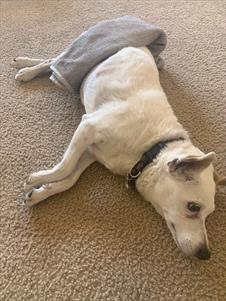Dog with ice pack towel

Ice packs should never be used directly against the skin. Photo by Heather Howell/VIN
Arthritis is a common disease in dogs that involves inflammation of the joints. Dogs can get arthritis at any age and the type they usually get is osteoarthritis. In this form of the disease, the smooth and shock-absorbing cartilage that covers the bones of a joint breaks down, leaving the bones to rub against each other. As you can imagine, this rubbing is quite painful and leads to limping, stiffness, inability to jump and difficulty climbing stairs. Based on these signs, physical exam findings and X-rays, your dog will be diagnosed with osteoarthritis.
Once it is determined your dog has arthritis, your veterinarian may recommend physical rehabilitation as part of a multimodal (several methods) treatment plan designed to enhance your dog's quality of life. In fact, they might refer you to a veterinarian specialized or certified in physical rehabilitation for dogs. The goals of physical rehabilitation include strengthening the muscles that support painful joints, improving joint mobility and range of motion, promoting joint health and reducing pain and inflammation.
Physical rehabilitation for arthritis includes hands-on techniques, low-impact exercise, cold and heat treatment, laser treatment, electrical stimulation, shock wave treatment and acupuncture, all of which are discussed below.
As always, only pursue these treatments at the recommendation of your veterinarian.
Hands-on Techniques
A veterinarian trained in physical rehabilitation might perform or teach you to perform some manual techniques on your dog. These include massage, stretching muscles and joint manipulation. Massaging may reduce pain and is often used to relax the dog prior to other exercises. Stretching muscles improves the flexibility of painful or tight muscles around affected joints. Joint manipulation involves manually moving the dog's joints to lubricate them, improve range of motion, reduce pain and increase joint stability and blood flow.
Therapeutic Exercise
Although it seems counterintuitive, exercise is actually quite important for arthritic dogs because the heavier a dog is, the more stress they put on their joints. In addition, fat itself can worsen the inflammation in your dog's joints. Exercise limits these consequences by keeping dogs at a proper weight. Exercise also promotes strong muscles, improves joint function and mobility and may reduce pain. Of course, the exercise needs to be low-impact so as to not put excess stress on the joints. Low-impact exercise includes swimming, short walks on a leash and underwater treadmills.
A rehabilitation veterinarian may also provide some exercises targeted at your pet's individual condition. If performing these exercises at home, you will be instructed on how to properly perform them and progress them over time.
Cold and Heat Treatment
Applying an ice pack to your dog's joints might reduce the inflammation and numb the pain associated with arthritis. It is usually recommended after exercise or during a flare of increased inflammation and pain. You should always wrap the ice pack in a towel before applying and never leave your dog alone with the ice pack.
Applying heat to arthritic joints may decrease pain, relax muscles and increase the flexibility of the joint tissues. Heat is often recommended before exercise. Warm towels, heat packs or ultrasound, which penetrates deeper than the other modalities, can be used for this purpose.
Laser Treatment
With laser treatment, a beam of light energy is applied to your dog's arthritic joints and the surrounding areas. This technique may reduce pain and inflammation and promote the healing of joint tissues.
Electrical Stimulation
Also known as Estim, this technique applies low-level electrical currents to arthritic joints through gel patches. For maximum effectiveness, the gel patches should stick directly to your dog's skin, which requires fur to be shaved at treatment areas. There are two types of electrical stimulation that might be recommended by your veterinarian. One is called transcutaneous electrical nerve stimulation (TENS), which is meant to reduce pain. The other type is called neuromuscular electrical stimulation (NMES), which is used to strengthen the muscles surrounding arthritic joints.
Shockwave Treatment
With shockwave treatment, a probe transmitting high energy sound waves is applied to arthritic areas. This technique is used to promote tissue healing, relieve pain and reduce inflammation.
Acupuncture
Acupuncture involves placing very small needles into specific locations that have been found to reduce pain and inflammation and improve nerve function.
Arthritis is a painful joint disease that dogs commonly suffer from. If your dog is diagnosed with this condition, your veterinarian will pursue a multifaceted treatment plan to reduce their pain and enhance their quality of life. Treatment will be tailored to your pet and it might include medication, lifestyle changes and physical rehabilitation. Many physical rehabilitation techniques are available and your veterinarian will recommend what the most appropriate forms.